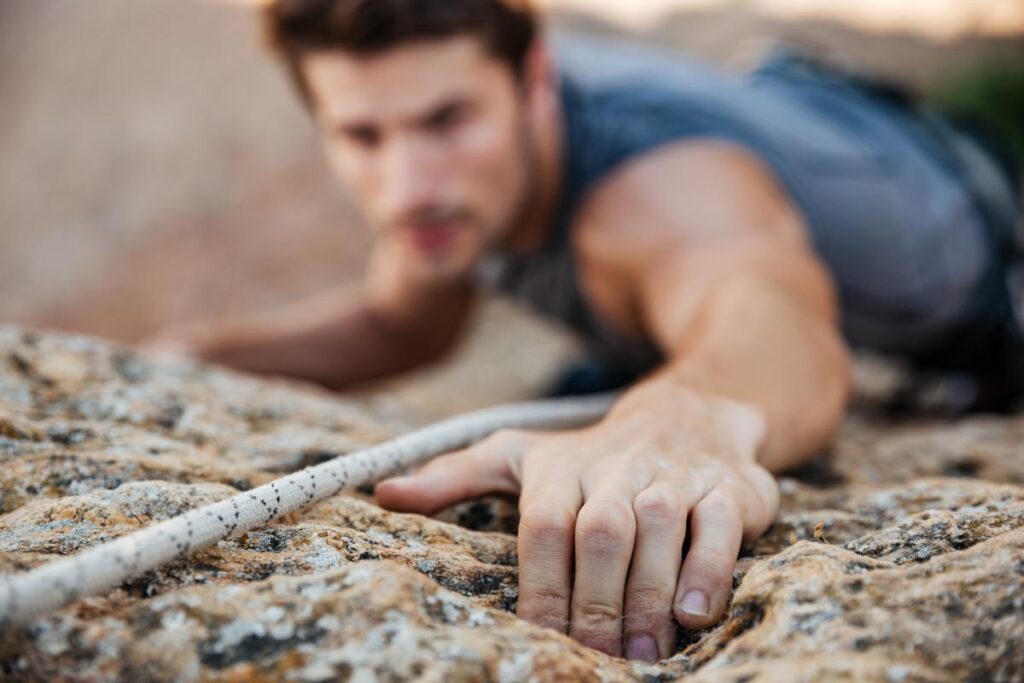Adrenaline addiction, also known as adrenaline junkie syndrome, is a condition where individuals become dependent on the rush of adrenaline produced by high-risk activities. This addiction is often characterized by a constant pursuit of thrill and excitement. And, can lead to dangerous behaviors and negative consequences. In this blog post, we will explore the complexities of adrenaline addiction and provide insights into managing and overcoming this challenging condition.
Contents
Can Adrenaline Be Addictive?
 Yes, adrenaline can be addictive. Adrenaline is also known as epinephrine. It is a hormone released by the adrenal glands in response to stress or excitement. It triggers the body’s “fight or flight” response, increasing heart rate, blood pressure, and energy levels. For some individuals, the rush of adrenaline becomes highly desirable, leading them to seek out activities that induce this response, such as extreme sports, risky behaviors, or high-stress environments.
Yes, adrenaline can be addictive. Adrenaline is also known as epinephrine. It is a hormone released by the adrenal glands in response to stress or excitement. It triggers the body’s “fight or flight” response, increasing heart rate, blood pressure, and energy levels. For some individuals, the rush of adrenaline becomes highly desirable, leading them to seek out activities that induce this response, such as extreme sports, risky behaviors, or high-stress environments.
This constant pursuit of adrenaline highs can result in a pattern of behavior similar to substance addiction, where the individual increasingly relies on the adrenaline rush to feel alive or satisfied. Over time, this addiction to adrenaline can have serious consequences. Additionally, the constant activation of the body’s stress response can have negative health effects. Just like with substance addiction, overcoming adrenaline addiction often requires professional help.
Why Am I So Obsessed With Adrenaline?
Feeling obsessed with adrenaline can stem from various psychological, physiological, and environmental factors. Here are a few reasons why you might be so drawn to adrenaline:
- Physiological Responses
Adrenaline triggers a powerful physical response, including increased heart rate, heightened senses, and a surge of energy. This response can create a feeling of euphoria or exhilaration. It can be highly rewarding. For some individuals, this sensation becomes addictive, as they seek to experience that intense rush repeatedly.
- Psychological Factors
Adrenaline can provide an escape from everyday stress or emotional struggles. Engaging in high-risk activities might offer a temporary distraction from negative feelings or provide a sense of control and achievement. Additionally, some people have a personality type that thrives on novelty and excitement. And, making them more prone to seeking adrenaline-inducing experiences.
Understanding the root causes of your obsession with adrenaline can be the first step toward managing it. If this obsession is leading to risky behavior, seeking professional help from a therapist or counselor can help.
What Are The Symptoms Of Adrenaline Addiction?
 Adrenaline addiction, often referred to as being an “adrenaline junkie,” can manifest through a variety of physical, emotional, and behavioral symptoms. Here are some common signs to look out for:
Adrenaline addiction, often referred to as being an “adrenaline junkie,” can manifest through a variety of physical, emotional, and behavioral symptoms. Here are some common signs to look out for:
1. Physical Symptoms
- Increased Heart Rate: Frequently experiencing a rapid heartbeat, even when not in high-stress situations.
- Insomnia: Difficulty falling or staying asleep due to a constant state of heightened alertness.
- Muscle Tension: Persistent muscle tightness or soreness from the frequent release of adrenaline.
- Fatigue: Chronic exhaustion resulting from the body being in a constant state of stress and arousal.
- Frequent Headaches: Stress-induced headaches due to the ongoing stimulation of the body’s stress response.
2. Emotional Symptoms
- Anxiety: Feeling anxious or on edge most of the time, often needing a thrill to feel normal or calm.
- Irritability: Becoming easily irritated or frustrated, particularly when not engaging in adrenaline-inducing activities.
- Mood Swings: Experiencing rapid mood changes, often feeling euphoric during high-adrenaline activities and depressed or empty afterward.
3. Behavioral Symptoms
- Risk-Taking Behavior: Continuously seeking out dangerous or high-risk activities, such as extreme sports, gambling, or reckless driving.
- Neglecting Responsibilities: Ignoring personal, professional, or social responsibilities in favor of pursuing adrenaline-inducing activities.
- Dependence on Thrills: Feeling a constant need for new and more intense experiences to achieve the same level of excitement.
- Avoiding Downtime: Having difficulty relaxing or enjoying calm activities, always seeking out the next thrill.
- Withdrawal Symptoms: Feeling restless, irritable, or depressed when unable to engage in high-adrenaline activities.
Recognizing these symptoms can help in identifying adrenaline addiction and seeking appropriate help to manage and overcome it.
Is It Bad To Crave Adrenaline?
Craving adrenaline is not inherently bad. In fact, many people enjoy and seek out the thrill and excitement that come from adrenaline-inducing activities. However, it can become problematic if the craving for adrenaline starts to negatively impact your life. Here are some considerations to keep in mind:
1. When It Can Be Positive
- Motivation and Excitement: Adrenaline can be a great motivator, pushing you to try new things, challenge yourself, and achieve goals you might not have thought possible.
- Improved Performance: In some situations, such as sports or high-pressure work environments, the adrenaline rush can enhance your performance and help you succeed.
- Healthy Stress Management: When managed well, seeking out controlled, adrenaline-inducing activities (like exercise or hobbies) can be a healthy way to cope with stress and maintain mental health.
2. When It Can Be Negative
- Risky Behavior: An excessive craving for adrenaline can lead to engaging in dangerous activities that put your health and safety, and that of others, at risk.
- Neglect of Responsibilities: If your desire for adrenaline takes precedence over your personal, professional, or social responsibilities, it can lead to problems in those areas of your life.
- Physical and Mental Health Issues: Chronic adrenaline stimulation can lead to issues like anxiety, insomnia, chronic fatigue, and even heart problems due to the constant state of arousal and stress.
- Addictive Behavior: Just like any other addiction, an overwhelming craving for adrenaline can create a cycle of dependency, where you need increasingly intense experiences to achieve the same level of excitement.
3. Finding Balance
It’s important to find a balance between enjoying adrenaline-inducing activities and maintaining overall health and well-being. Engaging in thrilling activities safely and in moderation can be a part of a healthy lifestyle.
However, if you find that your craving for adrenaline is becoming problematic, it may be beneficial to seek professional guidance to develop healthier coping mechanisms and ways to manage stress and excitement.
How to Overcome Adrenaline Addiction?
 Overcoming adrenaline addiction involves a combination of self-awareness, lifestyle changes, and professional support.
Overcoming adrenaline addiction involves a combination of self-awareness, lifestyle changes, and professional support.
Best options
Here are some steps to help manage and overcome this addiction:
Recognize the Problem
- Self-Assessment: Reflect on how often you seek out adrenaline-inducing activities and how they affect your life. Acknowledge if it’s becoming a compulsion.
- Understand the Impact: Be honest about the negative consequences, such as risk to personal safety, neglect of responsibilities, and physical or mental health issues.
Seek Professional Help
- Therapy: Engage in cognitive-behavioral therapy (CBT) or other forms of counseling to explore the underlying reasons for your addiction and develop healthier coping mechanisms.
- Support Groups: Join support groups where you can share experiences and gain insights from others facing similar challenges.
Develop Healthier Habits
- Exercise: Channel your need for excitement into regular physical activities like running, swimming, or team sports. These can provide a healthy adrenaline rush.
- Mindfulness and Relaxation: Practice mindfulness, meditation, or yoga to help reduce stress and improve your ability to relax without seeking external thrills.
- Hobbies: Find new hobbies that engage your mind and body in a fulfilling way, such as art, music, or learning a new skill.
Set Realistic Goals
- Gradual Change: Set small, achievable goals to gradually reduce your dependence on adrenaline-inducing activities. Celebrate each step forward.
- Balance: Aim for a balanced lifestyle that includes a mix of stimulating and calming activities.
Build a Support Network
- Family and Friends: Surround yourself with supportive people who understand your struggle and can provide encouragement and accountability.
- Mentors: Seek out mentors or role models who lead a balanced life and can offer guidance and support.
Address Underlying Issues
- Identify Triggers: Understand what triggers your need for adrenaline. Is it boredom, stress, or a need for control? Address these underlying issues directly.
- Emotional Health: Work on improving your overall emotional health by addressing any anxiety, depression, or other mental health issues that may be contributing to your addiction.
Create a Structured Routine
- Daily Schedule: Establish a daily routine that includes time for work, rest, and play. Having a structured schedule can reduce the impulsive need to seek out thrills.
- Sleep Hygiene: Ensure you get enough restful sleep. Poor sleep can exacerbate the need for adrenaline highs to combat fatigue.
Avoid High-Risk Situations
- Limit Exposure: Avoid places or situations where you are likely to be tempted to engage in high-risk behaviors.
- Plan Alternatives: Have alternative activities planned that can provide satisfaction without the need for an adrenaline rush.
Celebrate Progress
- Acknowledge Achievements: Regularly acknowledge and celebrate your progress, no matter how small. This positive reinforcement can motivate you to continue.
Overcoming adrenaline addiction is a journey that requires patience, persistence, and support. By taking proactive steps and seeking help, you can develop healthier ways to find excitement and fulfillment in your life.
Conclusion
Overcoming adrenaline addiction is challenging but achievable with the right approach and support. By recognizing the problem, seeking professional help, developing healthier habits, and building a strong support network, you can break free from the cycle of adrenaline dependence. Remember to celebrate your progress, however small, and strive for a balanced lifestyle that includes both excitement and relaxation.
If you or someone you know is struggling with adrenaline addiction, don’t hesitate to reach out for help. With commitment and effort, it’s possible to find healthier ways to experience thrill and fulfillment in life.
